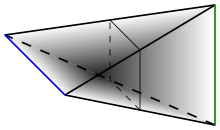Join (topology)

Geometric join of two line segments. The original spaces are shown in green and blue. The join is a three-dimensional solid in gray.
In topology, a field of mathematics, the join of two topological spaces A and B, often denoted by  , is defined to be the quotient space
, is defined to be the quotient space
where I is the interval [0, 1] and R is the equivalence relation generated by
At the endpoints, this collapses  to
to  and
and  to
to  .
.
Intuitively,  is formed by taking the disjoint union of the two spaces and attaching a line segment joining every point in A to every point in B.
is formed by taking the disjoint union of the two spaces and attaching a line segment joining every point in A to every point in B.
Properties
- The join is homeomorphic to sum of cartesian products of cones over spaces and spaces itself, where sum is taken over cartesian product of spaces:
and is homotopy equivalent to suspension of smash product of spaces:
Examples
- The join of subsets of n-dimensional Euclidean space A and B is homotopy equivalent to the space of paths in n-dimensional Euclidean space, beginning in A and ending in B.
- The join of a space X with a one-point space is called the cone CX of X.
- The join of a space X with
 (the 0-dimensional sphere, or, the discrete space with two points) is called the suspension
(the 0-dimensional sphere, or, the discrete space with two points) is called the suspension  of X.
of X. - The join of the spheres
 and
and  is the sphere
is the sphere  .
.
See also
References
- Hatcher, Allen, Algebraic topology. Cambridge University Press, Cambridge, 2002. xii+544 pp. ISBN 0-521-79160-X and ISBN 0-521-79540-0
- This article incorporates material from Join on PlanetMath, which is licensed under the Creative Commons Attribution/Share-Alike License.
- Brown, Ronald, Topology and Groupoids Section 5.7 Joins.




